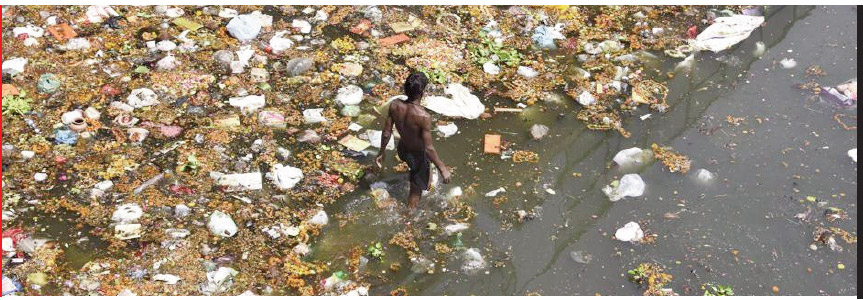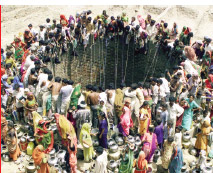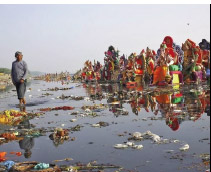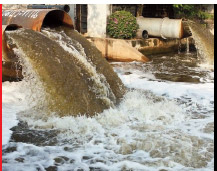Degradation all around
 Rakesh Lohumi
Rakesh Lohumi

The multiple challenges on the
environmental front the country
is facing today belie its age-old
cultural tradition of nature
worship and Vedic beliefs that
rivers, lakes, mountains and
forests are sacred entities which sustain life.
The earth was never treated as a resource
for economic exploitation but revered as
Mother Nature that sustained all forms of
life on the planet and, thus, cannot be
defiled.
The Vedic view maintain that all that
exists in nature is essential for survival of
human beings. However, neither the
ancient wisdom of the seers nor the
advances in the field of science and
technology made in recent times has
helped the country to preserve its
environment. It is in the midst of a huge
environmental crisis and the situation is
worsening progressively.
A multi-dimensional crisis
While climate change has thrown up
concerns like retreating glaciers, declining
precipitation, loss of biodiversity, frequent
extreme weather events, floods and
landslides, the ever-increasing human
activity is causing severe degradation of
environment due to growing pollution. The
impact of the unsustainable development
model being pursued in the country since
long has now started affecting the quality of
life.
India figures among
the world's most
polluted countries
today. The national
capital of Delhi has
been hogging
headlines for
clocking record levels
of air pollution
leading to an
emergency like
situation every
winter.
India figures among the world's most
polluted countries today. The national
capital of Delhi has been hogging
headlines for clocking record levels of air
pollution leading to an emergency like
situation every winter. In fact, out of the
world's 20 most polluted cities as many as
13 are in India. Not only surface water but
even ground water has been
contaminated in with chemicals and
other pollutants. Even venerated rivers
have been defiled and Ganga and
Yamuna are among the world's ten most
polluted rivers today.
With an increasing population and
growing economy water, land, forests and
other natural resources are bound to
come under mounting pressure. With just
2.2 per cent of the global land and 16 per
cent of the world population the country
needed to conserve its natural resources
and environment at all costs. However,
environmental concerns were
overlooked.
Lop-sided development policies, lax
enforcement laws and indifferent
governance made things worse.
Haphazard urbanization,
industrialization, unregulated mining,
indiscriminate felling of trees,
impounding and diversion of rivers for
power generation, construction of
highways and other development
projects have taken a huge toll on the
environment.
 The ruthless exploitation of limited
natural resources, injudicious use of
pesticides, excessive tapping of ground
water, indiscriminate deforestation and
the consequent natural habitat
destruction have led to sharp degradation
of ecosystems. These man-made factors
have further accentuated the impact of
global warming and pushed the country
into a multi-dimensional environmental
crisis .Cities have been burdened beyond
their carrying capacity, aggravating the
problem of traffic congestion, parking
space, water scarcity and waste disposal.
The ruthless exploitation of limited
natural resources, injudicious use of
pesticides, excessive tapping of ground
water, indiscriminate deforestation and
the consequent natural habitat
destruction have led to sharp degradation
of ecosystems. These man-made factors
have further accentuated the impact of
global warming and pushed the country
into a multi-dimensional environmental
crisis .Cities have been burdened beyond
their carrying capacity, aggravating the
problem of traffic congestion, parking
space, water scarcity and waste disposal.
Veritable gas chambers
 While increasing vehicular emissions
are adding to air pollution, the urban
waste is causing water and land pollution.
While increasing vehicular emissions
are adding to air pollution, the urban
waste is causing water and land pollution.
The free flowing streams and rivers are
becoming sludgy and cities turning into
veritable gas chambers due to unchecked
pollution. Every winter smog frequently
paralyses life in Delhi,the most polluted
capital city in the world along with Beijing.
In November 2016 the Air Quality Index
(AQI) touched a record high of 999
creating an emergency like situation as
the peak levels of PM10 (diameter 10
microns) and PM2.5 (2.5 microns) shot up
to levels ten times more than the safe
limits of 100 and 60,respectively.
The situation is no better in other
cities. As per the World Health
Organisation's (WHO) report "Ambient
Air Pollution 2016" India has the highest
number of 33 cities in the in the list of 100
most polluted cities of the world. In fact,
22 of its cities figured in the top 50 most
polluted cities. The impact on health can
be judged from the fact that at peak
pollution levels air quality in Delhi was as
bad that in hailing it amounted to
smoking 40 cigarettes a day. The Lancet
Commission has in its report ranked India
as number 1 in pollution related
deaths(1.8 million), followed by China
(1.58 million). In an estimated 9 million
pollution linked deaths the world over in
2015.
At present only about 25 per cent of
the total 62 million tonnes of garbage
being generated annually by 377 million
people living in urban areas is treated and
the rest 45 million tones is dumped
untreated. Further, most of the existing
landfills have exhausted their capacity
even though only half of the solid waste is directly reaching the landfills.
ruthless exploitation
of limited natural
resources, injudicious use
of pesticides, excessive
tapping of ground water,
indiscriminate
deforestation and the
consequent natural
habitat destruction have
led to sharp degradation
of ecosystems. These
man-made factors have
further accentuated the
impact of global warming
and pushed the country
into a multi-dimensional
environmental crisis.
As per projections in Planning
Commission Report (2014), based on 0.45
kg per capita per day waste generation, the
quantum of urban waste generated will
shoot up to 165 tonnes in 2031 and further
to 436 tonnes in 2050. Every year 1,175
hectare of land will be required for new
landfills for disposal.
The existing ordinary landfills
contaminate the underlying soil due to
seepage of solid waste. Scientific landfills
are designed to check seepage and leakage,
retard and reduce generation of methane
which can be used for producing electricity.
A scientific landfill at Narela-Bawana in
Delhi, which became operational recently,
may pave the way for scientific disposal of
garbage in the country.
Polluting rivers
The bulk of waste water also flows into
rivers or just seeps into land due to
inadequate treatment facilities. Untreated
and partially treated sewage, industrial
effluents and construction are the main
pollutants contaminating the water bodies,
besides silt due to accelerated soil erosion,
a consequence of large scale deforestation.
As per the Ministry of Statistics and
Programme Implementation 56.4 per cent
population was connected to sewer
network and bulk of the wastewater
released untreated.
As per a CPCB report out of the 61754
million litre per day (MLD) of sewage
generated treatment capacity exists only for
22963 MLD (32 %). The 35 metropolitan
cities collectively generated 15,644 MLD of
sewage but their treatment capacity was
only 8040 MLD. The treatment capacity
shortfall for 498 Class I cities is 68 % and 410
Class II cities is 92 %, the combined shortfall
comes to 70 percent.
Injudicious use of fertilizers, pesticides
and insecticides are also causing pollution
as agriculture run-offs carry the residual
chemicals to the rivers. The availability of
fresh water is constantly declining and the
quantum of waste-water and solid waste
being generated due to unbridled
urbanisation is increasing The streams are
getting contaminated. Natural flows are not
enough to absorb the load of pollutants.
Severe contamination of water sources was
a major cause of epidemics like jaundice
and other water-borne diseases.
 While the Swatch Bharat Mission
initiative has created awareness among
common people about cleanliness, a lot
more is needed to be done for proper
disposal of sewage and waste water to
achieve the target. The shortage of water
and lack of facility for disposal of excreta
is a big impediment. The growing
demand and declining availability of fresh
water makes it imperative for the country
to go for treatment and reuse of waste
water in a big way.
While the Swatch Bharat Mission
initiative has created awareness among
common people about cleanliness, a lot
more is needed to be done for proper
disposal of sewage and waste water to
achieve the target. The shortage of water
and lack of facility for disposal of excreta
is a big impediment. The growing
demand and declining availability of fresh
water makes it imperative for the country
to go for treatment and reuse of waste
water in a big way.
The only hope
 A consequence of political expediency,
myopic policies and bad governance the
unregulated urbanization has been a
major factor behind the rapid
degradation of environment. Multistoried
structures were allowed to come
up in and around the existing town
without augmenting the basic civic
amenities like water supply, sewerage,
garbage disposal, roads, public transport
and other required infrastructure.
Besides causing pollution, it is also
accentuating the rain havoc by triggering
floods.
A consequence of political expediency,
myopic policies and bad governance the
unregulated urbanization has been a
major factor behind the rapid
degradation of environment. Multistoried
structures were allowed to come
up in and around the existing town
without augmenting the basic civic
amenities like water supply, sewerage,
garbage disposal, roads, public transport
and other required infrastructure.
Besides causing pollution, it is also
accentuating the rain havoc by triggering
floods.
The increase in the frequency of urban
floods in recent years is fallout of reckless
constructions that totally destroyed
vegetation and the natural drainage
system. The natural channels that
drained out storm water have been
narrowed down or wiped out altogether.
With hardly any vegetative cover left even
a mild spell of rain results in huge run-offs
as the storm water flows quickly over
impervious surface. No surprise Gurgaon,
Bangaluru ,Delhi ,Mumbai and other
cities are experiencing frequent floods
during monsoon.
Instead of enforcing building
regulations governments across the
country, irrespective of the party in
power, have been coming out with
policies to regularise illegal structures and
encroachments. The situation has
become worse in and around urban
areas, where land prices are high, as
every inch of land is being covered. Even
drains, creeks, khads and rivers have
been gobbled up by builders.Large
colonies, clusters of multi-storied
buildings, roads and other constructions
have come up without proper drainage.
A country like India
with second largest
population in the world
and limited
environmental
resources has no option
but to come up with a
policy and effective
regulatory framework
to check deforestation,
control pollution,
protect water bodies,
regulate urbanisation
and restrict human
activity in ecologically
fragile areas.
The only hope
With elected governments going all out
to placate the offenders, it has been left to
the judiciary to step in and stem the rot.
Courts have been frequently forced to
intervene to make the indifferent regulatory
bodies to act against the violators. Recently,
the Himachal High Court quashed the
amendment to the state town and country
planning act vide which illegal structures
were sought to be regularised on "as is
where is" basis. The Supreme Court and
National Green Tribunal (NGT) have issued
several directions to the Centre and the
Delhi government to take steps to check air
pollution in the national capital but not
much headway has been made. In fact, the
authorities concerned try their best to find
ways and means to circumvent the court
orders or delay implementation.
China performing better
In contrast, China realised early that
economic growth at the cost of
environment will prove counterproductive
and took effective steps to curb pollution
and other negative fallouts of development
activities. In India environmental
governance continues to be a matter of
political expediency. There is no dearth of
technical expertise, laws, rules and
regulatory agencies only political will is
lacking. China is doing far better than India
in mitigating the impact of development
activities on environment. India and China
were ranked at 141th and 109th,
respectively, among 180 countries in the
global Environmental Performance Index
(EPI)-2016. EPI takes care of many highpriority
environmental issues, like resource
consumption, depletion of environmental
assets, pollution and species loss.
Besides, effectively checking pollution,
the country faces multiple challenges of
preserving the stressed forest reserves,
falling water table, depleting sources of
fresh water, melting glaciers, degrading soil,
protecting biodiversity and maintaining the
resilience of eco-systems which sustain
human livelihoods. However, the country
seems reluctant to address these
environmental concerns.
The two most populous countries faced
same environmental challenges but China
has managed to control pollution of its
rivers and urban air pollution over the past decade. Beijing and Delhi are two most
polluted capitals but air pollution has
dipped by 40 per cent in the former and
increased by 20 percent in the latter over
the past 15 years.
As per the WHO report on air pollution
China has only three cities as against
India's 13 cities in the list of world's most
polluted cities. Air pollution could reduce
life expectancy of 660 million affected
Indians who live in cities like Delhi by 3.2
years, while in case of China the reduction
will be marginally lower at three years.
Impact of climate change
 Lopsided development policies and
poor governance are aggravating the
fallout of global warming in the country,
particularly in Himalayan states. The
unrestrained spread of concrete jungle,
setting up of big hydropower plants,
mining projects, cement plants and
unscientific construction of roads have
hastened the process of environmental
degradation in the region with third
largest deposits of snow and ice after the
north pole and south pole and often
referred to as the "third pole". Large
chunks of forests have disappeared and
the increased run-offs from the
mountains are not only eroding the
precious top soil and silting up the rivers
but also causing floods downstream.
Lopsided development policies and
poor governance are aggravating the
fallout of global warming in the country,
particularly in Himalayan states. The
unrestrained spread of concrete jungle,
setting up of big hydropower plants,
mining projects, cement plants and
unscientific construction of roads have
hastened the process of environmental
degradation in the region with third
largest deposits of snow and ice after the
north pole and south pole and often
referred to as the "third pole". Large
chunks of forests have disappeared and
the increased run-offs from the
mountains are not only eroding the
precious top soil and silting up the rivers
but also causing floods downstream.
Declining snow & rain
The environmental fallout of
increasing biotic pressure is already
discernible in the form of decline in both
snowfall and monsoon precipitation. The
seasonal snow cover has benn receding
in regions areas like Shimla, Mussourie,
Manali, Dharamsala, Naimital ,Kasauni
and Kasauli which have witnessed rapid
development in recent times. Water
sources are drying up fast, leading to an
acute water scarcity during summer.
Large-scale deforestation and
concretisation have altered the microclimate
and as a result the seasonal
snowline is receding fast. As per studies
conducted by scientists of meteorological
department the snow season in Shimla
has been shrinking at an alarming rate of
11 days per decade since 1991 and the
overall precipitation during winter
(December to March) has also been
declining with the decadal average
The availability of
fresh water is
constantly declining
and the quantum of
waste-water and
solid waste being
generated due to
unbridled
urbanisation is
increasing .
With elected
governments going
all-out to placate the
offenders, it has been
left to the judiciary to
step in and stem the rot.
Courts have been
frequently forced to
intervene to make the
indifferent regulatory
bodies to act against
the violators.
coming down from 283.9 mm (1991- 2001)
to 235.1 mm (2001- 2011).
Rainfall data of Bhakra Beas
Management Board shows a steady decline
in monsoon (June-September) precipitation
catchment areas of Sutlej and Beas rivers.
The total rain has come down from 1,092
mm in 2008-09 to 621 mm in 2018-17, an
alarming decline of 44 per cent in less than
10 years. Reduction in rainfall was more
pronounced in north and northeast India,
mainly due to large-scale conversion of
forests to crop lands. It affected the evapotranspiration
process by which moisture is
transferred from soil to atmosphere
through plants. Unlike the deep rooted
forest vegetation, the shallow roots of crops
are unable to extract water which results in
reduced recycled precipitation.
At the same time frequent extreme
weather events are causing widespread
devastation across the country. A number
of major calamities like Kedarnath disaster,
floods in Mumbai, Bangluru, Chandigarh
and Chennai, Srinagar deluge, Ladakh
cloudburst and sudden surge in the Kosi
river together claimed thousands of lives
and caused widespread destruction. The
melting glaciers are giving rise to a new
hazard - glacier lake outburst floods (GLOFs)
- caused by moraine-dammed lakes. A risk
assessment carried out by Nepal-based
International Centre for Integrated
Mountain Development (ICIMOD) has
revealed the presence of over 8,000 glacial
lakes in the Hindu Kush-Himalayan region,
out of which about 200 are potentially
dangerous. As per the Himachal Centre for
Climate Change, the number of morainedammed
lakes has shot up by 109, from 596
in 2013 to 705 in 2015 in Himachal which
has already experienced one such event in
the bursting of Parechu Lake in Tibet.
A country like India with second largest
population in the world and limited
environmental resources has no option but
to come up with a policy and effective
regulatory framework to check
deforestation, control pollution, protect
water bodies, regulate urbanisation and
restrict human activity in ecologically fragile
areas, particularly the high altitude ranges
of Himalayas.
A Shimla-based seasoned
journalist, formerly with The
Tribune, and an expert on
environmental issues.




 Rakesh Lohumi
Rakesh Lohumi




